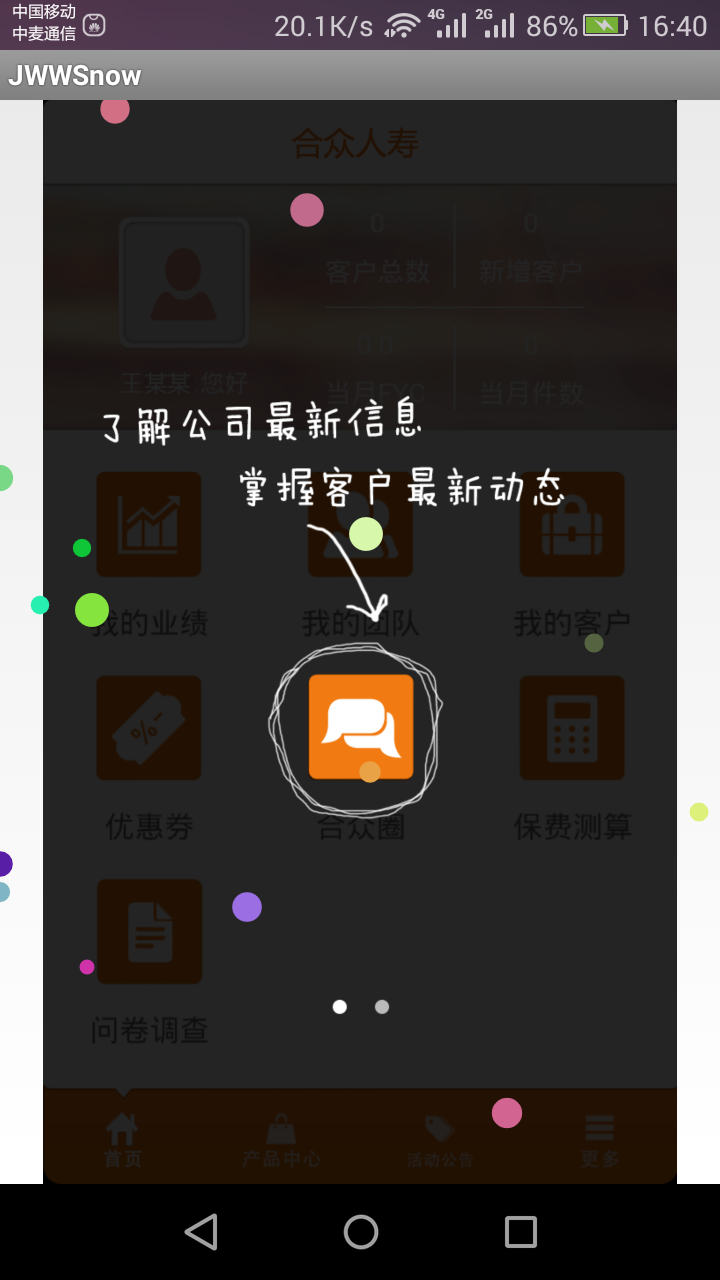声明:本文源码出自实现雪花飞舞效果(有改动)主要通过这篇文来分析自定义view的实现过程。
没事时,比较喜欢上网看看一些新的东西,泡在网上的日子就是一个很不错的网站。
下面开始了,哈哈。^_^
大家都知道,自定义view分成三个类型,1、是完全自定义,自己绘制,例如本文讲的例子。2、是Groupview,就是把一些安卓原生提供的控件组合起来,做成一个有多种功能的组合控件,如前面写过的android-oldman之TitleBar.就是这种。3、就是继承自安卓原来的控件,然后增加修改成自己需要的功能。如extends TextVeiw后,再里面做一些更改,text的位置,长度什么的。相比2,与3,第1种自定义view就是要继承自view,然后根据需要,测量,绘制。
最终要的效果是:看到没有,上面一些彩色的点,就是原来的雪花,当然,你可以通过修改参数,改变雪花数量。

下面就开始贴代码了,哈哈哈。
首先,先是定义view
1 package com.example.jwwsnow; 2 3 import java.util.ArrayList; 4 import java.util.HashMap; 5 import java.util.List; 6 7 import android.content.Context; 8 import android.graphics.Canvas; 9 import android.graphics.Color; 10 import android.graphics.Paint; 11 import android.util.AttributeSet; 12 import android.util.Log; 13 import android.view.View; 14 15 public class SnowView extends View { 16 17 Random random; 18 private static final int NUM_SNOWFLAKES = 15;//雪花数量 19 private static final int DELAY = 1;//画面延时刷新时间 20 21 private SnowFlake[] snowflakes;//雪花对像数组。 22 23 public SnowView(Context context) { 24 super(context); 25 } 26 27 public SnowView(Context context, AttributeSet attrs) { 28 super(context, attrs); 29 } 30 31 public SnowView(Context context, AttributeSet attrs, int defStyleAttr) { 32 super(context, attrs, defStyleAttr); 33 } 34 35 36 protected void resize(int width, int height) { 37 random = new Random(); 38 snowflakes = new SnowFlake[NUM_SNOWFLAKES]; 39 for (int i = 0; i < NUM_SNOWFLAKES; i++) { 40 //for循环生产雪花。 41 Paint paint = new Paint(Paint.ANTI_ALIAS_FLAG); 42 paint.setStyle(Paint.Style.FILL); 43 paint.setColor(Color.rgb(random.getColor(), random.getColor(), random.getColor())); 44 //返回的对象存入对象数组中去。 45 snowflakes[i] = SnowFlake.create(width, height, paint); 46 Log.i("SnowDemo", "时间::::::::::"+System.currentTimeMillis()); 47 } 48 } 49 50 /** 51 * View中方法的启动顺序onSizeChanged()>onDraw(); 52 */ 53 @Override 54 protected void onSizeChanged(int w, int h, int oldw, int oldh) { 55 super.onSizeChanged(w, h, oldw, oldh); 56 if (w != oldw || h != oldh) { 57 resize(w, h); 58 } 59 60 } 61 62 @Override 63 protected void onDraw(Canvas canvas) { 64 super.onDraw(canvas); 65 for (SnowFlake snowFlake : snowflakes) { 66 //得到雪花对象,绘制。 67 snowFlake.draw(canvas); 68 } 69 70 getHandler().postDelayed(runnable, DELAY);//得到子线程,设置5ms延时,每5ms在主线程绘制一次界面。。 71 } 72 73 private Runnable runnable = new Runnable() { 74 @Override 75 public void run() { 76 invalidate();//此方法会把原来的视图清除掉,并重新调用veiw.onDraw方法。 77 } 78 }; 79 }
可以看到,重写了view中的几个方法:
onSizeChanged();
这个方法,是先于onDrow方法执行的。判断view的size是不是改变,如果改变,则由系统调用。然后才是执行onDrow()方法。
在本例此方法中,系统通过对view的尺寸的判断,来调用reSize()方法,并把width与heigh传递过去。
在reSize()方法中。定义了雪花对象数组SnowFlakes[],通过for循环,创建指定数量的雪花对象,并在for循环中创建Paint对象,设置画笔。(ps:Paint与Canvas,paint就像我们平时做画用的画笔,我们可以选择画笔的颜色,粗细,抗锯齿,空心,实心,是不是带阴影等。Canvas,画布,我们可以用画布来承载我们要画的具体事物,如矩形,圆形,线等。要把ptint与canvas区分开,因为功用不同。canvas决定要画的具体是什么,print决定用什么样的性质去画嘿嘿,被我说晕没。)。然后调用下面要贴的雪花Calss的create方法。这个方法主要是设置一些尺寸,位置等的。然后把这些尺寸位置等参数状态以对象的形式保存在SnowFalkes[]数组中,供下面的onDraw方法中去用这些参数做画。
onDraw()方法中,for循环,依次对SnowFalkes[]对象数组中的每个雪花进行绘画。然后用Handler在主线程中定时重绘一次。
snowFlake.draw(canvas);方法则是具体的进行绘制了。下面先贴代码,再接着讲。
1 package com.example.jwwsnow; 2 3 import android.graphics.Canvas; 4 import android.graphics.Paint; 5 import android.graphics.Point; 6 7 public class SnowFlake { 8 9 private static final float ANGE_RANGE = 0.1f; // 10 private static final float HALF_ANGLE_RANGE = ANGE_RANGE / 2f; 11 private static final float HALF_PI = (float) Math.PI / 2f; 12 private static final float ANGLE_SEED = 25f; 13 private static final float ANGLE_DIVISOR = 10000f; 14 private static final float INCREMENT_LOWER = 2f; 15 private static final float INCREMENT_UPPER = 4f; 16 private static final float FLAKE_SIZE_LOWER = 7f;//最小雪花大小 17 private static final float FLAKE_SIZE_UPPER = 20f;//最大雪花大小 18 19 private final Random random; 20 private final Point position; 21 private float angle; 22 private final float increment; 23 private final float flakeSize; 24 private final Paint paint; 25 26 public static SnowFlake create(int width, int height, Paint paint) { 27 Random random = new Random(); 28 int x = random.getRandom(width);//得到[0~width)的整数width与height都是外层view的尺寸。 29 int y = random.getRandom(height); 30 Point position = new Point(x, y);//设置雪花刚一出来的随机位置。 31 //设置Random.getRandom(ANGLE_SEED)/ANGLE_SEED得到[0~1)再*ANGE_RANGE得到[0~0.1f)的数据,再减去0.05得到[-0.05~0.05)的数据。 32 float angle = random.getRandom(ANGLE_SEED) / ANGLE_SEED * ANGE_RANGE + HALF_PI - HALF_ANGLE_RANGE; 33 //得到[2f~4f)的随机数据 34 float increment = random.getRandom(INCREMENT_LOWER, INCREMENT_UPPER); 35 //得到[7f~20f)的随机数据 36 float flakeSize = random.getRandom(FLAKE_SIZE_LOWER, FLAKE_SIZE_UPPER); 37 //返回雪花对象。 38 return new SnowFlake(random, position, angle, increment, flakeSize, paint); 39 } 40 41 SnowFlake(Random random, Point position, float angle, float increment, float flakeSize, Paint paint) { 42 this.random = random; 43 this.position = position; 44 this.angle = angle;//[-0.05~0.05) 45 this.increment = increment;//[2f~4f) 46 this.flakeSize = flakeSize;//[7f~20f) 47 this.paint = paint; 48 } 49 50 private void move(int width, int height) { 51 //x方向的偏移量小,y方向的大,是为了让雪花快点落下。 52 double x = position.x + (increment * Math.cos(angle));//Math.cos(angle)约为1 53 double y = position.y + (increment * Math.sin(angle));//Math.sin(0.05~-0.05) = +-[0~8.7) 54 /* 55 *设置雪花的位置为正,不跑出屏幕。[0~1)*2*ANGLE_SEED-ANGLE_SEED等于+-(0~ANGLE_SEED],为+-(0~25f]。然后再/10000f====+-(0~0.0025], 56 *然后再加[-0.05~0.05)泥妈,快算晕了。大神们果然不好理解。(-0.0525~0.0525) 57 */ 58 59 angle += random.getRandom(-ANGLE_SEED, ANGLE_SEED) / ANGLE_DIVISOR; 60 61 position.set((int) x, (int) y);//设置新的位置 62 63 if (!isInside(width, height)) { 64 //如果雪花不在view视图内,则重设置他们的位置。 65 reset(width); 66 } 67 } 68 69 private boolean isInside(int width, int height) { 70 //TODO 设置雪花位置 71 int x = position.x; 72 int y = position.y; 73 //判断x坐标x>雪花尺寸加1距原点的距离(负方向)。x<background宽,同样的方式理解y。由于上面的设置,其实x方向,雪花是不可能跑出屏幕的,只有y方向上会。 74 return x >= -flakeSize - 1 && x + flakeSize <= width && y >= -flakeSize - 1 && y - flakeSize < height; 75 76 } 77 78 private void reset(int width) { 79 //当雪花落到屏幕最下方以下时,重新设置雪花从 80 position.x = random.getRandom(width);//x轴设设置一个view内的随机位置就行 81 position.y = (int) (-flakeSize - 1);//view的(0,0)点在view的左上角,所以,当y为负时,则在view的上方。看起来像是一个新的雪花从上落下。 82 angle = random.getRandom(ANGLE_SEED) / ANGLE_SEED * ANGE_RANGE + HALF_PI - HALF_ANGLE_RANGE; 83 } 84 85 public void draw(Canvas canvas) { 86 //绘制方法 87 int width = canvas.getWidth(); 88 int height = canvas.getHeight();//雪花所整个view高度与宽度 89 move(width, height);//雪花移动,传的参数为view的的北景大小。 90 //画一个个雪花。其实就是画一个个球。其坐标,尺寸,画笔都是原来在create方法时就定义 了的,之后保存在flakesnow数组里了。 91 canvas.drawCircle(position.x, position.y, flakeSize, paint); 92 } 93 94 95 }
先跳到前面的onSizeChange()方法来说。可以看到,当调用SnowFlake.create()方法后,最后返回的是:(里面的Random对象也是重新进行封装的,马上贴上)
1 return new SnowFlake(random, position, angle, increment, flakeSize, paint);
这个是用来绘制SnowFlake时需要的参数。然后在onSizeChange()方法调用的reSize()方法中保存进入了雪花数组SnowFlakes[i]。
再跳到上面大段代码前面的接着说,在onDraw()方法中,for循环会依次绘制每个雪花。snowFalke.draw().就是snowflakes[i] = SnowFlake snowFlake();
snowFlake再调用自己的draw()方法。由于前面每个SnowFlake对象都保存了每个雪花的参数,所以在draw()中,用的就直接使用了。
雪花是要下落的,则在draw()方法中,调用move()方法,来设置每个雪花的位置。当雪花位置跑出屏幕后再调用reset()方法,重新设置雪花从屏幕最上方重新落下。
下面是代码中用来设置随机数据的Random对象封装。
1 package com.example.jwwsnow; 2 3 import java.util.ArrayList; 4 import java.util.List; 5 6 public class Random { 7 8 private static final java.util.Random RANDOM = new java.util.Random(); 9 10 public float getRandom(float lower, float upper) { 11 float min = Math.min(lower, upper);//返回两者较小的一个。 12 float max = Math.max(lower, upper); 13 return getRandom(max - min) + min;//返回的是比最大的小,比最小的大的数。 14 } 15 16 public float getRandom(float upper) { 17 return RANDOM.nextFloat() * upper;//Random.nextFloat()生成[0~1)的数. 18 } 19 20 public int getRandom(int upper) { 21 return RANDOM.nextInt(upper);//随机生成比[0~upper)的数值。 22 } 23 public int getColor(){ 24 return RANDOM.nextInt(255);//随机生成[0~255)整数。 25 26 } 27 }
然后就是使用了:xml引用,要把路径写完整。
1 <?xml version="1.0" encoding="utf-8"?> 2 <RelativeLayout xmlns:android="http://schemas.android.com/apk/res/android" 3 xmlns:tools="http://schemas.android.com/tools" 4 android:layout_width="match_parent" 5 android:layout_height="match_parent" 6 tools:context="com.stylingandroid.snowfall.MainActivity"> 7 8 <ImageView 9 android:id="@+id/image" 10 android:layout_width="match_parent" 11 android:layout_height="match_parent" 12 android:layout_centerInParent="true" 13 android:contentDescription="@null" 14 android:scaleType="fitCenter" 15 android:src="@drawable/tree" /> 16 17 <com.example.jwwsnow.SnowView 18 android:layout_width="match_parent" 19 android:layout_height="match_parent" 20 android:layout_alignBottom="@id/image" 21 android:layout_alignEnd="@id/image" 22 android:layout_alignLeft="@id/image" 23 android:layout_alignRight="@id/image" 24 android:layout_alignStart="@id/image" 25 android:layout_alignTop="@id/image" /> 26 </RelativeLayout
本文主要用来复习自定义view的流程。建议先看原文。^_^
下面把我注释改变后的一些代码发上来,仅做研究用(eclipse版的。。。)。
ca,博客园不能上传代码。360云盘 访问密码 ce1b。